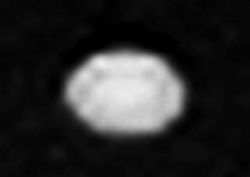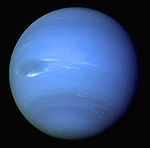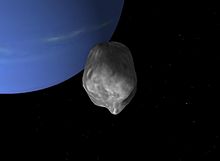- Despina (moon)
-
Despina  Despina as seen by Voyager 2 (smeared horizontally)Discovery
Despina as seen by Voyager 2 (smeared horizontally)DiscoveryDiscovered by Stephen P. Synnott[1] and Voyager Imaging Team Discovery date July 1989 Epoch 18 August 1989 Semi-major axis 52 526 ± 1 km Eccentricity 0.0002 ± 0.0002 Orbital period 0.33465551 ± 0.00000001 d Inclination - 0.216 ± 0.014° (to Neptune equator)
- 0.06° (to local Laplace plane)
Satellite of Neptune Physical characteristicsDimensions 180×148×128 km[3][4] Mean radius 75 ± 3 km[5] Volume ~1.8×106km³ Mass ~2.2×1018 kg
(based on assumed density)Mean density ~1.2 g/cm³ (estimate)[5] Equatorial surface gravity ~0.026 m/s2[a] Escape velocity ~0.063 km/s[b] Rotation period synchronous Axial tilt zero Albedo 0.09[3][5] Temperature ~51 K mean (estimate) Apparent magnitude 22.0[5] Despina (
 /dɨˈspiːnə/ di-spee-nə or /dɨˈspaɪnə/ di-spy-nə; Latin: Despœna,; Greek: Δέσποινα), also known as Neptune V, is the third closest inner satellite of Neptune. It is named after Despoina, a nymph who was a daughter of Poseidon and Demeter.
/dɨˈspiːnə/ di-spee-nə or /dɨˈspaɪnə/ di-spy-nə; Latin: Despœna,; Greek: Δέσποινα), also known as Neptune V, is the third closest inner satellite of Neptune. It is named after Despoina, a nymph who was a daughter of Poseidon and Demeter.Despina was discovered in late July 1989 from the images taken by the Voyager 2 probe. It was given the temporary designation S/1989 N 3.[6] The discovery was announced (IAUC 4824) on August 2, 1989, but the text only talks of "10 frames taken over 5 days", giving a discovery date of sometime before July 28. The name was given on 16 September 1991.[7]
Despina is irregularly shaped and shows no sign of any geological modification. It is likely that it is a rubble pile re-accreted from fragments of Neptune's original satellites, which were smashed up by perturbations from Triton soon after that moon's capture into a very eccentric initial orbit.[8]
Despina's orbit lies close to but outside of the orbit of Thalassa and just inside the Le Verrier ring. As it is also below Neptune's synchronous orbit radius, it is slowly spiralling inward due to tidal decceleration and may eventually impact Neptune's atmosphere, or break up into a planetary ring upon passing its Roche limit due to tidal stretching.
Notes
- ^ Surface gravity derived from the mass m, the gravitational constant G and the radius r: Gm/r2.
- ^ Escape velocity derived from the mass m, the gravitational constant G and the radius r: √2Gm/r.
References
- ^ Planet Neptune Data http://www.princeton.edu/~willman/planetary_systems/Sol/Neptune/
- ^ Jacobson, R. A.; Owen, W. M., Jr. (2004). "The orbits of the inner Neptunian satellites from Voyager, Earthbased, and Hubble Space Telescope observations". Astronomical Journal 128 (3): 1412–1417. Bibcode 2004AJ....128.1412J. doi:10.1086/423037.
- ^ a b Karkoschka, Erich (2003). "Sizes, shapes, and albedos of the inner satellites of Neptune". Icarus 162 (2): 400–407. Bibcode 2003Icar..162..400K. doi:10.1016/S0019-1035(03)00002-2.
- ^ Williams, Dr. David R. (2008-01-22). "Neptunian Satellite Fact Sheet". NASA (National Space Science Data Center). http://nssdc.gsfc.nasa.gov/planetary/factsheet/neptuniansatfact.html. Retrieved 2008-12-13.
- ^ a b c d "Planetary Satellite Physical Parameters". JPL (Solar System Dynamics). 2008-10-24. http://ssd.jpl.nasa.gov/?sat_phys_par. Retrieved 2008-12-13.
- ^ Marsden, Brian G. (August 2, 1989). "Satellites of Neptune". IAU Circular 4824. http://www.cbat.eps.harvard.edu/iauc/04800/04824.html. Retrieved 2011-10-26.
- ^ Marsden, Brian G. (September 16, 1991). "Satellites of Saturn and Neptune". IAU Circular 5347. http://www.cbat.eps.harvard.edu/iauc/05300/05347.html. Retrieved 2011-10-26.
- ^ Banfield, Don; Murray, Norm (October 1992). "A dynamical history of the inner Neptunian satellites". Icarus 99 (2): 390–401. Bibcode 1992Icar...99..390B. doi:10.1016/0019-1035(92)90155-Z.
External links
- Despina Profile by NASA's Solar System Exploration
- Neptune's Known Satellites (by Scott S. Sheppard)
- Astronomy Picture of the Day featuring Despina and its shadow transiting Neptune
Moons of Neptune Generally listed in increasing distance from Neptune Regular (inner) Triton Irregular See also Neptune Discovery 
Characteristics - Rings
- Great Dark Spot
- Small Dark Spot
- The Scooter
- Kuiper belt
Moons Exploration Trojans Miscellaneous Categories:
Wikimedia Foundation. 2010.

